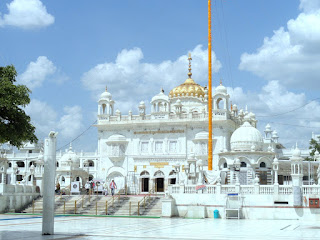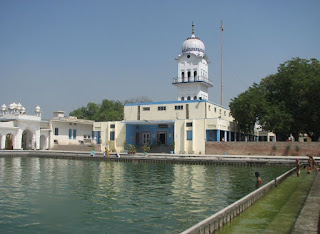Takht Sri Harmandir Sahib - Patna
Takht Patna Sahib enjoys the privilege of being the birthplace of the Tenth Guru Sri Guru Gobind Singh Ji. He was born here on December 22, 1666. There stands, at the sacred place a magnificent holy shrine, called Takht Sri Harmandir Sahib. It is situated in one of the old quarters of Patna city, once known as Kucha Farrukh Khan, now known as Harmandir Gali. It is regarded as one of the holiest of five Takhts, the seat of the Sikh authority. Two of the five Takhts are located outside Punjab. These are Takht Sri Harmandir Sahib, Patna in Bihar, and Takht Sri Hazoor Sahib at Nanded in Maharashtra. Three Takhts are in Punjab. These are Akal Takht Amritsar, Keshgarh Sahib Anandpur and Sri Damdama Sahib at Talwandi Sabo in Bhatinda district. Besides, there are over one hundred important holy Sikh shrines spread over the length and breadth of the country which are humming with the sacred message of the Sikh Gurus and reminding the people of their teachings. These are visited by thousands of pilgrims throughout the year.
This sacred place has the honour of being visited by the first Guru Sri Guru Nanak Dev ji and the Patna Sahib, Takht Sri Harmandir Sahib Patna, Gurudwara Patna Sahib ninth Guru Sri Guru Tegh Bahadur ji. It is from this place that the commandment of valiance and fearlessness was issued to the Sikh fraternity. The ninth Guru waxed eloquent about this to justify ways of God to men. "This is why I was born and set Patna Sahib as my place of work". This very line indicates that Sri Guru Gobind Singh Ji was born at this sacred place. After bidding an adieu to his promising childhood at Sri Patna Sahib, Guru Sahib stepped into the holy land of Sri Anandpur Sahib.
Gurudwara Patna Sahib is regarded as the centre for propagating Sikhism in the east. As history would have it, Takht Sri Patna Sahib is the second accepted and acknowledged Takht of the Sikhs.
In fact the new order Khalsa Panth was set up by the tenth Guru, Guru Gobind Singh with emphasis on unity and integration. He baptised Panj Pyaras on Baisakhi day at Anandpur Sahib in 1699 and founded the Khalsa Panth. The Panj Piaras represented the different segments of society. Thus the tenth Guru created Khalsa Panth for the protection of the downtrodden and deprived sections of people.
It was 'Sher-e-Punjab' Maharaja Ranjit Singh who, first of all, undertook the task of raising a monumental Sikh Temple at this place. The site where the present Harmandir stands was originally called the haveli of Salis Rai John, who was a great devotee of Guru Nanak. He was so much influenced by the teachings of the Guru that he converted his palatial house into a dharamsala. When Guru Tegh Bahadur visited Patna, he stayed in the same place. A magnificent house was built above the dharamsala of Salis Rai.Mullah Ahmed Bukhari,the author of Mirat-ul-Ahwal Jahan Nama, who stayed at Patna for some time at the close of 18th century, has made a reference to Harmandir. He writes, "Over the birthplace of Guru Gobind Singh, the Sikhs have raised a public edifice, made it a place of power and strength, and call it 'Harmandir'. It is also called 'Sangat' and is held in great esteem and veneration. They have made it a place of pilgrimage. Maharaja Ranjit Singh started the work of reconstructing the Harmandir in 1839 following destruction by fire, but did not survive to see the new structure. Again in 1934, when the entire Bihar was rocked by an earthquake some portion of Harmandir fell down. Construction of the present building was taken up on November 19, 1954 and was completed in about three years.
Some relics of the tenth Guru are also preserved in this shrine. Among them is a pangura (cradle) with four stands covered with Golden plates. Guruji during his childhood used to sleep in this cradle. Moreover, four iron arrows, sacred sword of the Master and a pair of his sandals are also preserved. Hukamnamas of Guru Gobind Singh and Guru Tegh Bahadur contained in a book are also kept in this holy Gurdwara.
Takht Sri Harimandir Sahib - the principal shrine at Patna Sahib and one of the five Takhts or the highest seats of religious authority for the Sikhs, marks the site of the Chhoti Sangat. Guru Tegh Bahadur had first alighted at Bari Sangat at Gae Ghat from where he was brought in a procession to this place which had once been the commodious mansion of Salas Rai, the jeweler, and where Raja Fateh Chand Maini now built a new house to accommodate the holy family. Guru Tegh Bahadur himself leaving his family here in the care of his brother-in-law Kirpal Chand and the local sangat proceeded on further to the east. Guru Gobind Singh was born here. He spent his early childhood here until his departure for Punjab in 1670. The house continued to be maintained as a holy place of worship. Its building was replaced by Maharaja Ranjit Singh during 1837-39 with a square flat-roofed hall surrounded by a covered passage for circumambulation. Rulers of Patiala, Jind and Faridkot jointly added several rooms and a gateway to the compound in 1887. An earthquake in 1934 seriously damaged the older building of the Takht Sahib. The present five-storey building was constructed during 1954-57 through kar-seva under the supervision of Sant Nischal Singh and Sant Kartar Singh. The sanctum representing the room where Guru Gobind Singh was born has a circum ambulatory passage around it. Adjacent to it is the spacious high-ceiling congregation hall. The arch of the door of the inner sanctum opening on the congregation hall is covered with gilded copper plates embossed with floral design matching the marble sculpture on the interior walls. Of the three canopied seats facing the hall, the central one has Guru Granth Sahib seated on it. Guru Granth Sahib is placed on the seat on its right and the Dasam Granth on the one on the left, both attended by granthis holding whisks over them. The compound of the Takht Sahib also has several blocks of rooms for staff and visitors as well as for Guru ka Langar. The relics preserved here include a pair of wooden sandals, an old gown, several weapons and hukamnamas.
This sacred place has the honour of being visited by the first Guru Sri Guru Nanak Dev ji and the Patna Sahib, Takht Sri Harmandir Sahib Patna, Gurudwara Patna Sahib ninth Guru Sri Guru Tegh Bahadur ji. It is from this place that the commandment of valiance and fearlessness was issued to the Sikh fraternity. The ninth Guru waxed eloquent about this to justify ways of God to men. "This is why I was born and set Patna Sahib as my place of work". This very line indicates that Sri Guru Gobind Singh Ji was born at this sacred place. After bidding an adieu to his promising childhood at Sri Patna Sahib, Guru Sahib stepped into the holy land of Sri Anandpur Sahib.
Gurudwara Patna Sahib is regarded as the centre for propagating Sikhism in the east. As history would have it, Takht Sri Patna Sahib is the second accepted and acknowledged Takht of the Sikhs.
In fact the new order Khalsa Panth was set up by the tenth Guru, Guru Gobind Singh with emphasis on unity and integration. He baptised Panj Pyaras on Baisakhi day at Anandpur Sahib in 1699 and founded the Khalsa Panth. The Panj Piaras represented the different segments of society. Thus the tenth Guru created Khalsa Panth for the protection of the downtrodden and deprived sections of people.
It was 'Sher-e-Punjab' Maharaja Ranjit Singh who, first of all, undertook the task of raising a monumental Sikh Temple at this place. The site where the present Harmandir stands was originally called the haveli of Salis Rai John, who was a great devotee of Guru Nanak. He was so much influenced by the teachings of the Guru that he converted his palatial house into a dharamsala. When Guru Tegh Bahadur visited Patna, he stayed in the same place. A magnificent house was built above the dharamsala of Salis Rai.Mullah Ahmed Bukhari,the author of Mirat-ul-Ahwal Jahan Nama, who stayed at Patna for some time at the close of 18th century, has made a reference to Harmandir. He writes, "Over the birthplace of Guru Gobind Singh, the Sikhs have raised a public edifice, made it a place of power and strength, and call it 'Harmandir'. It is also called 'Sangat' and is held in great esteem and veneration. They have made it a place of pilgrimage. Maharaja Ranjit Singh started the work of reconstructing the Harmandir in 1839 following destruction by fire, but did not survive to see the new structure. Again in 1934, when the entire Bihar was rocked by an earthquake some portion of Harmandir fell down. Construction of the present building was taken up on November 19, 1954 and was completed in about three years.
Some relics of the tenth Guru are also preserved in this shrine. Among them is a pangura (cradle) with four stands covered with Golden plates. Guruji during his childhood used to sleep in this cradle. Moreover, four iron arrows, sacred sword of the Master and a pair of his sandals are also preserved. Hukamnamas of Guru Gobind Singh and Guru Tegh Bahadur contained in a book are also kept in this holy Gurdwara.
Takht Sri Harimandir Sahib - the principal shrine at Patna Sahib and one of the five Takhts or the highest seats of religious authority for the Sikhs, marks the site of the Chhoti Sangat. Guru Tegh Bahadur had first alighted at Bari Sangat at Gae Ghat from where he was brought in a procession to this place which had once been the commodious mansion of Salas Rai, the jeweler, and where Raja Fateh Chand Maini now built a new house to accommodate the holy family. Guru Tegh Bahadur himself leaving his family here in the care of his brother-in-law Kirpal Chand and the local sangat proceeded on further to the east. Guru Gobind Singh was born here. He spent his early childhood here until his departure for Punjab in 1670. The house continued to be maintained as a holy place of worship. Its building was replaced by Maharaja Ranjit Singh during 1837-39 with a square flat-roofed hall surrounded by a covered passage for circumambulation. Rulers of Patiala, Jind and Faridkot jointly added several rooms and a gateway to the compound in 1887. An earthquake in 1934 seriously damaged the older building of the Takht Sahib. The present five-storey building was constructed during 1954-57 through kar-seva under the supervision of Sant Nischal Singh and Sant Kartar Singh. The sanctum representing the room where Guru Gobind Singh was born has a circum ambulatory passage around it. Adjacent to it is the spacious high-ceiling congregation hall. The arch of the door of the inner sanctum opening on the congregation hall is covered with gilded copper plates embossed with floral design matching the marble sculpture on the interior walls. Of the three canopied seats facing the hall, the central one has Guru Granth Sahib seated on it. Guru Granth Sahib is placed on the seat on its right and the Dasam Granth on the one on the left, both attended by granthis holding whisks over them. The compound of the Takht Sahib also has several blocks of rooms for staff and visitors as well as for Guru ka Langar. The relics preserved here include a pair of wooden sandals, an old gown, several weapons and hukamnamas.






Comments
Post a Comment